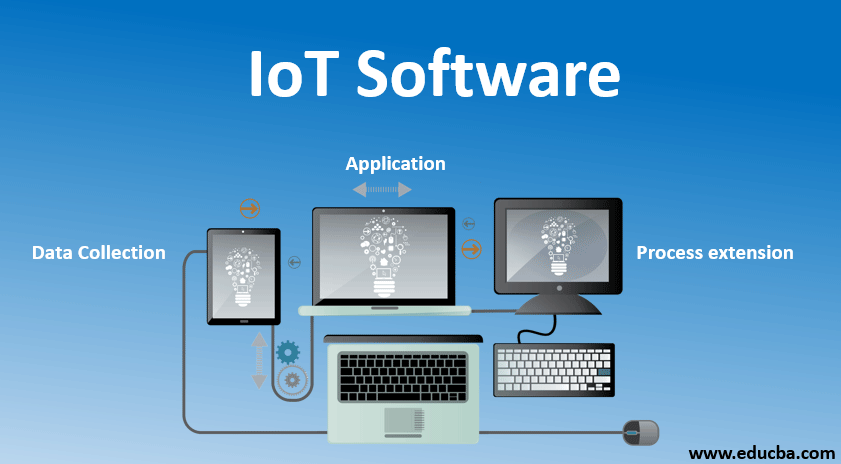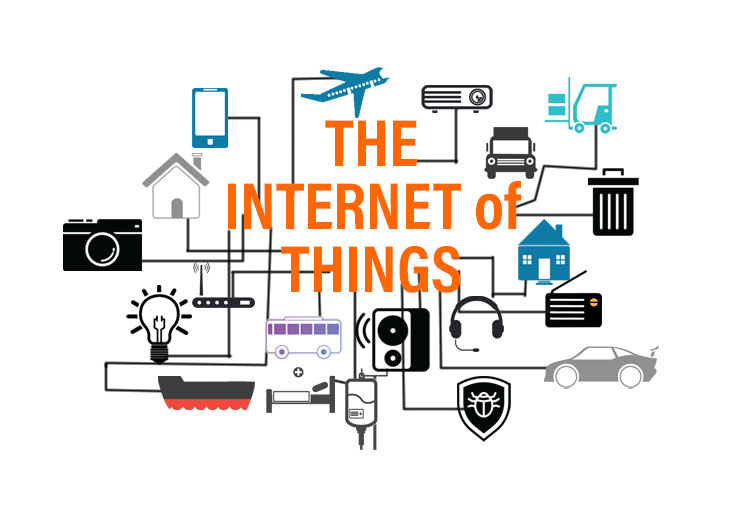Updated March 21, 2023

Introduction to IoT Software
The following article provides an outline for IoT Software. IoT is about [Internet + (Sense and Communication)]. Things of things are connected through the internet. Let’s take the example of the Mi fitness band- To use this band, a user should install the Mi-fit app to connect to a phone. Band calculates total hours of sleep, the number of calories burn, heart rate monitoring, and sleep analysis. Users can see all the information on mobile phones. Every device, area, software, and sensor are connected, and we can access it through phone or computer.
Impact of the Internet
- E-learning- we can get knowledge of any subject, technology, through the internet. We can learn anything from scratch to the expert level.
- Business-70%-90% of business happens worldwide online.
- Communication- Humans can communicate with other humans overseas through internet-based applications. For example – Skype, Webex, WhatsApp, or Facebook.
- Entertainment -Games, video.
- Medical-Drastically developed. For example- Doctors can track the patient’s history and give the right treatment, and doctors present in a different location can suggest to each other what treatment should be done to take care of the patient.
IoT Software
IoT software addresses areas of networking and action through platforms, partner systems, and middleware.
The individual and master applications are responsible for:
- Data Collection
- Application
- Process Extension
1. Data Collection
Devices and technology connected over IoT can monitor and measure data in real-time. This data can offer valuable insight to save time, money and energy.
- Medical Data – Heartbeat, Blood Pressure, Sugar Level, etc.
- Educational Data – Attendance and Learning.
- Location – Traffic Congestion.
- Agriculture data – Weather and Soil Information.
Process IoT Data
A massive amount of data is generated by sensors and devices; it should be processed Before information is passed to the user. As we can understand that data doesn’t come in one format, we should perform some steps before we analyze the data.
- Transform the data to a uniform format, ensure that format is compatible with your application.
- Store and create a backup of newly transformed data.
- Filter repeated or unwanted data to improve accuracy.
IoT Data Analytics
There are various types of data generated by IoT devices; we must apply analysis tools to handle this data. Valuable information is collected from a massive amount of data that will be used to improve applications and business processes.
Types of analytics we can apply to IoT data:
i. Prescriptive Analytics
It is used to find the best of solution as per the given situation.
- Descriptive analytics will provide insight into what has happened.
- Predictive analytics will predict and forecast what might happen, will determine the best solutions among choices.
ii. Spatial Analytics
It is used to find hidden patterns and relationships from the IoT data, combining geospatial analytics, business data, and operational data. Industrial, travel, and agriculture companies enrich data from IoT sensors with business applications and geographic data from GIS.
iii. Streaming Analytics
It refers to the data processing of real-time data collected from IoT devices. We can use real-time data to analyze urgent situations and provide an immediate response.
For example – Traffic analysis and tracking of financial transactions.
iv. Time Series Analytics
Observing data points over time with proper transform may reveal valuable information about system trends and behaviour. For example, Health-monitoring and Weather-monitoring platforms are most benefited from time-series analytics.
IoT data is everywhere; it is in our homes, in our cars, in our offices. IoT devices generate a massive amount of data. If we collect, process, and analyze data, consumers or organizations will gain valuable insight. It will be helpful to predict future decisions and help them grow.
2. Application of IoT Software
Application of IOT software are as follows:
i. Connected Homes
- Initial commercial availability in the 1980s, but at a great cost.
- One of the fastest-growing areas in IoT is Connected to Homes.
- Devices such as Smart TVs
- Generally, it consists of a network of internally connected devices that access the internet via a proprietary hub device.
ii. Connected Vehicles
- Any vehicle that is equipped with a wireless connection provides internet access.
- Estimated that nearly 60% of cars on the road will be networked by 2025.
- Enables advanced safety features.
- Provides easier vehicle software update.
- Facilitates autonomous vehicles (facilities like entertainment, information, navigation capabilities).
- It can also provide remote unlock/climate control via smartphone.
iii. Industrial Applications
a. Enables data collection from myriad endpoints in an industrial workflow.
Collected data can be used for:
- Improve operational efficiency.
- Inform decision making.
- Improve customer service.
- Increase collaboration within an organization.
- Enhance profits and revenue.
b. IoT in the industry can aid in:
- Developing new services.
- Enhancing productivity.
iv. Wearable Devices
a. Generally divided into categories.
- Fitness and Environment – Wrist bands, watches, and clothes.
- Health – Monitor medical metrics(heart rate, blood sugar), communicates results to both the patient and physician.
- Security, identity and transactions – Banking cards, NFC devices, Security badges(provides identification validation for access to buildings and resources).
b. It must be small and energy-efficient.
3. Process Extension
Applications extend the reach of existing systems and software. It provides the most effective systems. It integrates predefined devices for a specific purpose, such as allowing certain mobile devices access. It provides improved productivity and data collection.
Conclusion – IoT Software
Humans should care about IoT because we all need a simplified and secure life. Getting this value from the Internet of Things helps to have a platform for creating and managing applications, running analytics, storing and securing your data.
Recommended Articles
This is a guide to IoT Software. Here we discuss the impact of IoT and different types of IoT software with their types. You may also look at the following articles to learn more –


